
The Prado Museum, officially known as Museo Nacional del Prado, is the main Spanish national art museum, located in central Madrid. It is widely considered to house one of the world's finest collections of European art, dating from the 12th century to the early 20th century, based on the former Spanish Royal Collection, and the single best collection of Spanish art. Founded as a museum of paintings and sculpture in 1819, it also contains important collections of other types of works. The Prado Museum is one of the most visited sites in the world, and is considered one of the greatest art museums in the world. The numerous works by Francisco Goya, the single most extensively represented artist, as well as by Hieronymus Bosch, El Greco, Peter Paul Rubens, Titian, and Diego Velázquez, are some of the highlights of the collection. Velázquez and his keen eye and sensibility were also responsible for bringing much of the museum's fine collection of Italian masters to Spain, now the largest outside Italy.
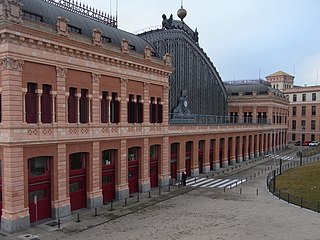
Madrid Atocha, also named Madrid Puerta de Atocha, is the largest railway station in Madrid. It is the primary station serving commuter trains (Cercanías), regional trains from the south and southeast, intercity trains from Navarre, Cádiz and Huelva (Andalusia) and La Rioja, and the AVE high speed trains from Girona, Tarragona and Barcelona (Catalonia), Huesca and Zaragoza (Aragon), Sevilla, Córdoba, Málaga and Granada (Andalusia), Valencia, Castellón and Alicante. These train services are run by the Spanish national rail company, Renfe. As of 2019, this station has daily services to Marseille in France.

The Goya Awards are Spain's main national annual film awards.

Paseo de Recoletos is a wide boulevard in central Madrid leading from Plaza de Cibeles to Plaza de Colón.

The 1977 Atocha massacre was an attack by right-wing extremists in the center of Madrid on January 24, 1977, which saw the assassination of five labor activists from the Communist Party of Spain (PCE) and the workers' federation Comisiones Obreras (CC.OO). The act occurred within the wider context of far-right reaction to Spain's transition to constitutional democracy following the death of dictator Francisco Franco. Intended to provoke a violent left-wing response that would provide legitimacy for a subsequent right-wing counter coup d'état, the massacre had an immediate opposite effect; generating mass popular revulsion of the far-right and accelerating the legalization of the long-banned Communist Party.
The Salon of Colombian Artists is a cultural event in Colombia, considered the event with most trajectory. This event is celebrated every year between August 5 and September 12 with two main categories a national event and a set of regional contests.
Madrid, the capital of Spain, is divided into 21 districts, which are further subdivided into 131 administrative wards. Additional neighborhoods exist outside the boundaries of administrative borders. Each district is governed by a body named Junta Municipal de Distrito. Residents of Madrid are typically called Madrileños.

Gregorio Fernández was a Spanish Baroque sculptor. He belongs to the Castilian school of sculpture, following the style of other great artists like Alonso Berruguete, Juan de Juni, Pompeyo Leoni, and Juan de Arfe.

Paseo de la Castellana, commonly known as La Castellana, is a major street in Madrid, Spain. Cutting across the city from South to North, it has been described as the "true structuring axis" of the city.

Nuevos Ministerios is a major multimodal rail station on the Madrid Metro and the Cercanías Madrid commuter rail network. It is located beneath the Nuevos Ministerios government complex and the AZCA financial centre at the junction of the Paseo de la Castellana and Joaquín Costa and Raimundo Fernández Villaverde streets in Madrid, Spain. It services the districts of Tetuán, Chamberí, and Chamartín. The station serves Metro Line 6, Line 8, and Line 10, as well as Cercanías Lines C-1, C-2, C-3, C-4, C-7, C-8, and C-10. It is located in Metro fare zone A and Cercanías fare zone 0.

Luis Salvador Carmona was a Spanish Baroque sculptor who came from a family of artists.
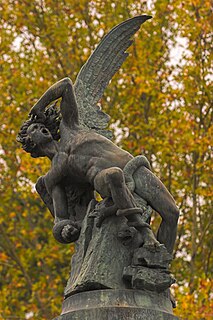
The Fuente del Ángel Caído is a fountain located in the Buen Retiro Park in Madrid, Spain.

Nuevos Ministerios is a government complex in central Madrid, Spain. The complex houses several government departments: Development, Labour, Social Security, and Ecological Transition. It is located in the block delimited by the Paseo de la Castellana, the Raimundo Fernández Villaverde street, Agustín de Betancourt street and the San Juan de la Cruz square.
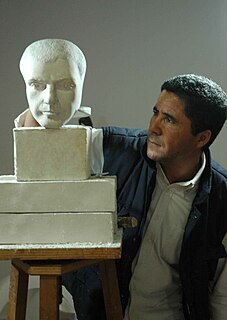
Mustafa Hamed Moh Arruf is a Spanish sculptor.

The Monument to Isabella the Catholic is an instance of public art located in Madrid, Spain. A work by Manuel Oms, the monument is a sculptural bronze ensemble consisting of an equestrian statue of Isabella of Castile, accompanied by Pedro González de Mendoza and Gonzalo Fernández de Córdoba.

The Palacio de Congresos de Madrid, also known as Palacio de Congresos or Palacio de Congresos y Exposiciones, is a convention centre in Madrid, Spain. Located in the Paseo de la Castellana, it is unused since 2012. The building's façade prominently displays a ceramic mosaic reproducing a work by Joan Miró.
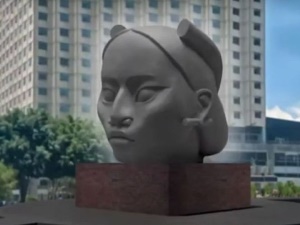
Tlalli was a proposed sculpture of a large indigenous woman's head by contemporary artist Pedro Reyes. It was proposed to replace the Monument to Christopher Columbus along Mexico City's Paseo de la Reforma.

Woman with Mirror is a 1987 bronze sculpture in Madrid, Spain, by the Colombian sculptor Fernando Botero. The 1,000-kilogram (2,200 lb) sculpture is of a nude woman with a large figure lying on her front; this body shape is a trademark of the sculptor.
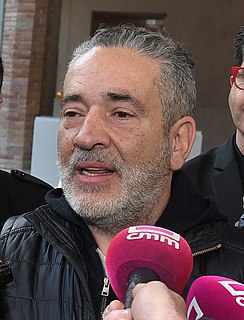
Eladio de Mora-Granados, known artistically as dEmo, is a Spanish artist. He is known for his large and colourful sculptures that resemble toys.
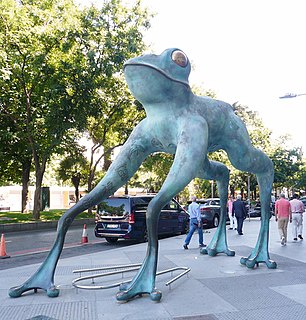
Lucky Frog is a bronze sculpture by the Spanish artist dEmo, installed in Madrid, Spain, in 2014, outside the Casino Gran Madrid on the Paseo de Recoletos. The sculpture is 5 metres (16 ft) tall and weighs 2,000 kilograms (4,400 lb).


















